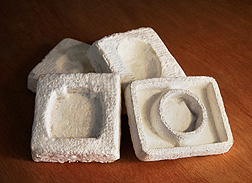This page has been archived and is being provided for reference purposes only. The page is no longer being updated, and therefore, links on the page may be invalid.
| Read the magazine story to find out more. |
|
|
Biodegradable Packaging from Cotton Waste
By Rosalie Marion BlissDecember 9, 2013
Proprietary agricultural waste blends provided by U.S. Department of Agriculture (USDA) scientists to industry partners are being used in a new process that literally grows custom packaging products to protect computers and other breakables during shipping.
These biodegradable blends were developed by Agricultural Research Service (ARS) engineer Greg Holt and his colleagues at Lubbock, Texas. ARS is USDA's chief intramural scientific research agency.
The process involves combining cotton gin waste and fungi inside a cast, called a "tool," where the two ingredients become one, resulting in a spongy-looking material similar in appearance to polystyrene foam. The custom-shaped end product is providing a cost-effective "green" alternative to extruded polystyrene foam packaging—an estimated $2 billon market.
Holt works at the ARS Cotton Production and Processing Research Unit in Lubbock. His industry partner, Ecovative Design of Green Island, N.Y., developed the patented method that uses fungi as a workhorse.
Woody cotton waste is blended, pasteurized, and embedded into a customized cast tool. Then the tool is injected with the fungus, which grows onto, in, and around the cotton waste, eventually forming a new, consistently textured, solid mass. Once the tool is opened, a custom-shaped solid mass emerges, which is biodegradable, compostable and flame retardant, but has the cushioning strength of synthetic packing material.
To learn which blends meet or exceed the same characteristics of extruded polystyrene foam, the lab evaluated the physical and mechanical properties of six different cotton-byproduct blends as a substrate for the fungal colonization.
Each blend was inoculated with a single fungus using two different inoculation methods, for a total of 12 treatments that were evaluated for numerous physical and mechanical properties. Overall, the treatments tested well, and the results indicated that the blend and inoculation method needed are based on the end-use of the product.
The study was published in September 2012 in the Journal of Biobased Materials and Bioenergy.
Read more about this research in the November/December 2013 issue of Agricultural Research magazine.

